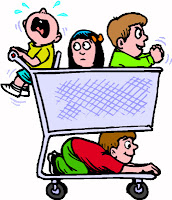Images: Courtesy The Big Box of Art
NOTE TO NEWCOMERS
This is Max Tell with my 8th instalment of writing exercises to give the poems you write for kids a unique personal flair and a bit of a bite. Note: A reference to 'poems' also includes songs. A reference to 'songs' refers only to songwriting.
A special thanks to Sheree Fitch who's workshop on writing more personal and exciting poetry for kids inspired the creation of 'Koetry for Pids'.
Today's topic:
Foot
I've already talked about stressed and unstressed syllables. A foot is a way of notating patterns of syllable stress. Let's look at Jack and Jill again.
/ ^ / ^ / ^ /
JACK and JILL went UP the HILL
^ / ^ / ^ / ^
To FETCH a PAIL of WA-ter.
You will notice in the example above that the dominant pattern of stressed and unstressed syllables is ( ^ / ) an unstressed syllable followed by a stressed syllable or (da DUM).
( ^ / ) equals one iambic foot or an iamb. In English, there are 7 major feet. Don't forget to clap your hands with the rhythm, a soft clap for unstressed syllables and a strong clap for stressed syllables.
iamb*: One Iamb foot equals one unstressed syllayble followed by a stressed syllable as in 'I SAW', ( ^ / ) or (da DUM).
^ / ^ / ^ / ^ /
I SAW three SHIPS come SAI-ling BY
Clap your hands to the rhythm. (da DUM, da DUM, da DUM)
trochee**:One trochee foot equals one stressed syllayble followed by an unstressed syllable as in 'MAry, ( / ^ ) or (DUM da).
/ ^ / ^ / ^ / ^
MA-ry, MA-ry, QUITE con-TRAR-y
anapest*:One anapest foot equals two unstressed syllaybles followed by a stressed syllable as in 'I am TALL', ( ^ ^ / ) or (da da DUM).
^ ^ / ^ ^ / ^ ^ / ^ ^ /
I am TALL, I am SMALL, I am NO-thing at ALL
Clap your hands to the rhythm. (da da DUM, da da DUM, da da DUM)
dactyl**: One dactyle foot equals one stressed syllayble followed by two stressed syllables, as in 'RED stockings', ( / ^ ^ ) or (DUM da da).
/ ^ ^ / ^ ^
RED stockings, BLUE stockings
Clap your hands to the rhythm. (DUM da da, DUM da da)
spondee***: One spondee foot equals two stressed syllables, one after the other, as in 'TOUCH BLUE', ( / / ) or (DUM DUM).
/ / ^ / ^ ^ /
TOUCH BLUE, your WISH will come TRUE
pyrric***: One pyrric foot equals two unstressed syllaybles one after the other, as in 'and the', ( ^ ^ ) or (da da).
^ ^ / / ^ ^ / /
and the BLACK BAT in the DARK CAVE
A Special Note to Teachers: When teaching poetry to young children or beginners don't worry about the names of the feet. Make the clapping fun. Make it play. As I have mentioned before:
Hockey lovers never begin by loving the rules,
they learn the rules because they love the game.
Photo: courtesy of The Big Box of Art
- * Iambic and anapestic feet rise from unstressed to stressed syllables, so are called rising meters.
- ** Trochaic and dactylic feet fall from stressed syllables to unstressed syllables, so are called falling meters.
- *** Spondaic and pyrric feet are never used throughout a poem, but only for variety or emphasis.
Although a poet usually establishes a specific rhythm pattern and primarily sticks with that pattern throughout, variation of pattern is the key to giving your poetry life and vitality. Without variation a poem may appear rhythmically flat and boring, especially with longer poems and choruses.
OH, DEAR! WHAT can the MAT-ter BE?
OH, DEAR! WHAT can the MAT-ter BE?
OH, DEAR! WHAT can the MAT-ter BE?
JOHN-ny's so LONG at the FAIR.
Photo: courtesy of The Big Box of Art
Meter
Meter is the number of feet in a line, where one foot contains at least one stressed syllable.
monometer: one foot
^ /
I AM
demeter: two feet
/ ^ /
HERE I AM
trimeter: three feet
/ ^ / ^ /
COCK-a-DOOdle-DO.
tetrameter: four feet
^ / ^ / ^ / ^ /
I HAD a LIT-tle HOB-by HORSE
pentameter: five feet
^ / ^ / ^ / ^ / ^ /
Whos-EV-er ROOM this IS should BE a-SHAMED!
hexameter: six feet
heptameter: seven feet
octameter: eight feet
I can't remember running across any six to eight foot lines in poetry, but that doesn't mean you shouldn't try a hand at it yourself. You may come up with a gem.
Now, it's your turn. Write on. Share your poems with others and in the comments section below.
For more of Max's poems, check out The Land of Graws.
www.maxtell.ca
Max on Facebook
Resources:
Sheree Fitch
Writing Stories in Rhythm & Rhyme
Shel Silverstein
Scansion: For Advanced Poets
Rhythm & Meter: Advanced Study
Essential Children's Collection
Next week's topic:
Rhyme / An Introduction
What poetry question would you like answered? Point of View? Rhyme? Something of your choice? Student questions are also welcome. Your comments below would be greatly appreciated.
Bye for now and see you soon.
Have a great writing day.
Max
Have a great writing day.
Max
Love writing, but love editing more.




No comments:
Post a Comment